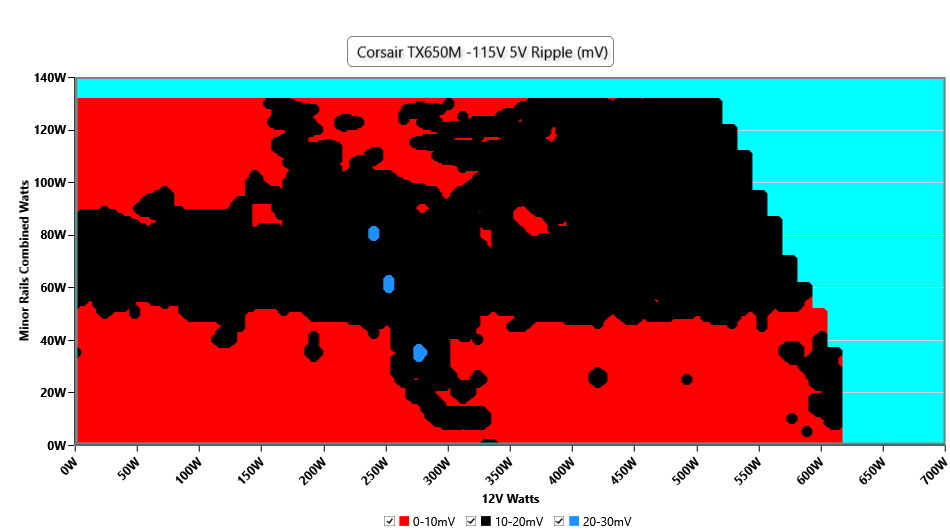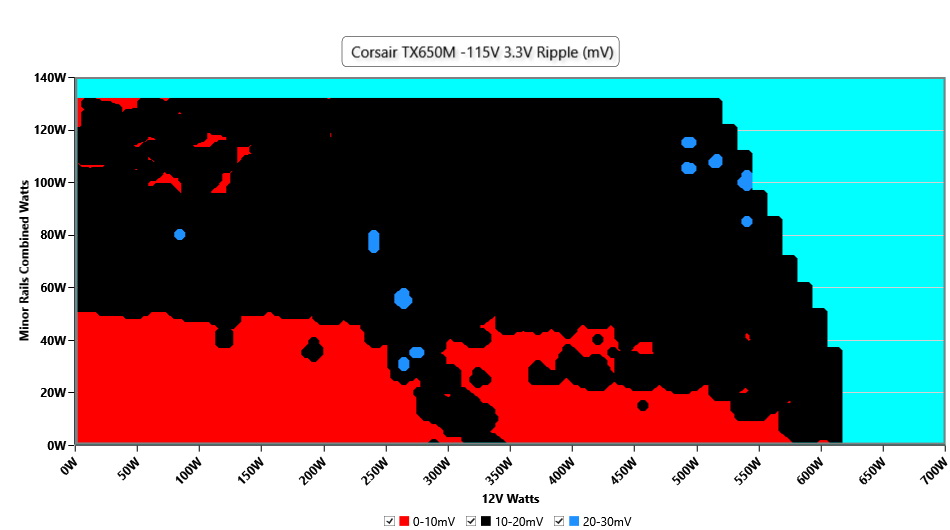Why you can trust Tom's Hardware
Protection Features
Check out our PSUs 101 article to learn more about PSU protection features.
| Protection Features | Row 0 - Cell 1 |
| OCP (Cold @ 26°C) | 12V: 68.4A (134.12%), 11.951V 5V: 36.5A (146%), 4.915V 3.3V: 37.6A (150.4%), 3.257V 5VSB: 5.5A (183.33%), 5.039V |
| OCP (Hot @ 42°C) | 12V: 68.2A (133.73%), 11.960V 5V: 35.6A (142.4%), 4.921V 3.3V: 37.2A (148.8%), 3.257V 5VSB: 5.5A (183.33%), 5.038V |
| OPP (Cold @ 27°C) | 817.5W (133.58%) |
| OPP (Hot @ 43°C) | 815.7W (133.28%) |
| OTP | ✓ (181°C @ 12V Heat Sink) |
| SCP | 12V to Earth: ✓ 5V to Earth: ✓ 3.3V to Earth: ✓ 5VSB to Earth: ✓ -12V to Earth: ✓ |
| PWR_OK | Accurate but lower than 16ms |
| NLO | ✓ |
| SIP | Surge: MOV Inrush: NTC Thermistor & Bypass relay |
Under hot and cold conditions, the OCP triggering points are correctly set for the 12V rail, but too high for the minor rails. There is no need for 37A at 3.3V!
DC Power Sequencing
According to Intel’s most recent Power Supply Design Guide (revision 1.4), the +12V and 5V outputs must be equal to or greater than the 3.3V rail at all times. Unfortunately, Intel doesn't mention why it is so important to always keep the 3.3V rail's voltage lower than the levels of the other two outputs.



No problems here since the 3.3V rail is always lower than the other two.
Cross Load Tests
To generate the following charts, we set our loaders to auto mode through custom-made software before trying more than 25,000 possible load combinations with the +12V, 5V, and 3.3V rails. The deviations in each of the charts below are calculated by taking the nominal values of the rails (12V, 5V, and 3.3V) as point zero. The ambient temperature during testing was between 30 to 32 degrees Celsius (86 to 89.6 degrees Fahrenheit).
Load Regulation Charts




Efficiency Graph
Ripple Graphs
The lower the power supply's ripple, the more stable the system will be and less stress will also be applied to its components.




Infrared Images
We apply a half-load for 10 minutes with the PSU's top cover and cooling fan removed before taking photos with a modified Fluke Ti480 PRO camera able to deliver an IR resolution of 640x480 (307,200 pixels).
Get Tom's Hardware's best news and in-depth reviews, straight to your inbox.



The hottest parts are two diodes right next to the standby transformer. These diodes belong to the 5VSB circuit, and at 100 degrees Celsius, their derating factor is 50%. They form a clamp circuit for the voltage going to the 5VSB circuit's controller. The temperatures on the other parts are low.
MORE: Best Power Supplies
MORE: How We Test Power Supplies
MORE: All Power Supply Content
Current page: Protection Features, DC Power Sequencing, Cross-Load Tests and Infrared Images
Prev Page Load Regulation, Hold-Up Time, Inrush & Leakage Current, Efficiency and Noise Next Page Transient Response Tests, Timing Tests, Ripple Measurements and EMC Pre-Compliance Testing
Aris Mpitziopoulos is a contributing editor at Tom's Hardware, covering PSUs.
-
daris98 Seems that they did a good job at keeping things in check. Everything is better than its predecessor, though, I was expecting that It'd be a good lot quieter. What I'm hoping is that they will be able to sell this for cheap in my country. The Enermax Revolution DF sells for cheaper than the old TX650M and I see no reason why I should get the TX. Hopefully the new version will be cheaper than the DF.Reply
